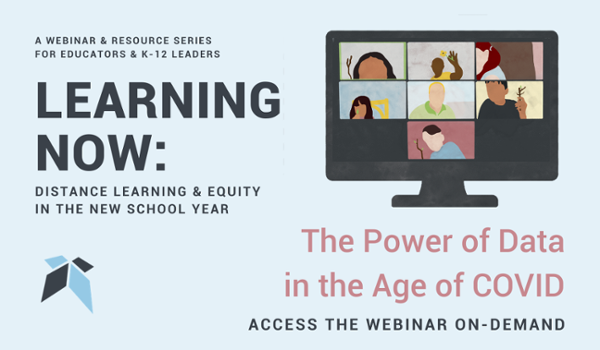As a new mom, I cared deeply about two things: my baby’s well-being and my sleep. I could go without showering or hot meals, but I was NOT well equipped to deal with the lack of sleep. And I was fairly lucky - my son slept about as normally as you can expect a newborn to sleep. However, any disruption in that pattern, and I immediately scrambled: “He didn’t sleep last night. I MUST try these five new things to get him back on track.” Sometimes they worked, and sometimes the shift in routine actually made things worse. My hyper-focus on the short run cues meant that I was super reactive to one piece of information but failed to take a look at the big picture. Conversely, there were times I didn’t have the energy or brainpower to try new things – I ignored the information my son was giving me because I simply didn’t know how to use the data or what to do.
As an educator, I am passionate about the power of data to drive improvements in our schools. However, just as I was either hyper-reactive to or totally ignored little changes in my baby’s sleep, I’ve been both hyper-reactive and oblivious to cues in my professional practice. With a lot of learning and a little bit of rest (my baby is now a big boy and reliably sleeps, thank goodness!) I thought it would be helpful to reflect and share a few tips on how to use data systematically to drive your practice forward.
Be clear on your goal
This might sound obvious but be clear on what it is you’re trying to do from the outset. That means, before you ever look at the data, get clear on your theory of action, and know what questions you’re trying to answer by looking at the data. Some questions you might ask yourself: what am I trying to accomplish in my schools? How will I know it’s working? You cannot know whether or not you’re making progress unless you’re clearly measuring it and you cannot be responsive and make adjustments to reaching the goal unless you know your north star.
Be consistent
Whenever my son was having a sleep regression I tended to double down on tracking his sleep. This tendency is rational, but won’t help you understand the full picture. Whatever data you’re collecting, collect it consistently so you can see long term trends. Doing this will allow you to “attend to the variability” – that means digging deeper to understanding both the peaks AND the valleys. Looking for areas that stick out and then asking why can help you learn from that stand-out point and apply the lessons learned in other places. For example, in reflecting on your data over time do you notice that one of your classes or schools is doing way better than the others? Why is that? Dig in and uncover all of the reasons and think about which lessons you can apply to other contexts. If you don’t have the data consistently measured it is hard to pinpoint these examples and the reasons for them.
Have a process
One way to be consistent and systematically reflect on your data is to use a data protocol. Protocols can help you take a step back and think about the big picture questions before you dive into the details. One protocol you may find useful is the Predict, Observe, Infer protocol. First, before you look at the data, state what you expect to find in the data. Do you think there’s going to be improvement or regression? Are there going to be any subgroup differences? Then, look at the data. What do you notice about the overall trend? Are there any differences among subgroups that you see? Finally, try to understand why those trends exist. To do that you might want to do interviews, gather qualitative feedback, or triangulate with other data you have available to you.
Ask lots of questions
Whenever you notice some trend or tendency in the data, pause and ask why. If you can’t find the answer in the data, triangulate using other information. Ask teachers, look at other data sources, examine short term and long term trends. I want to name that there’s a tension here: you don’t want to overreact to one piece of information, but you also want to pay attention to moments of variability and understand why. Through the variability, we can learn how to improve, so it’s essential to understand it. That doesn’t mean you start over and make big changes based on that information, but it does mean you ask the questions and do the work to understand why. A protocol you can use to support this practice is the 5 Whys. State the trend you see, then ask yourself, “why?” Write down one possible answer and then ask yourself and answer “why?” four more times. Consider if you can implement a solution at that point.
Example: My 3rd block of reading class is two full class periods behind in content.
Why? After the lunch break, several students forget to log back in, so we start late.
Why? They’re tired after a morning full of being online and need the break.
Why? There aren’t any breaks built into the morning schedule in our school, and teachers in other classes frequently go over their class block times.
Why? There isn’t a bell schedule to keep us on track.
Why? We are relying on synchronous teaching techniques virtually and teaching up to the last minute.
Based on this reflection, I might test out some asynchronous learning time to kick off my classes so that students can have a bit of transition time for all of my classes, especially that third block.
Build a community of data gurus
There’s an African Proverb that comes to mind here: “If you want to go fast, go alone. If you want to go far, go together.” In order to use data to drive improvement in your schools, you cannot do it alone. Data reflection and improvement must be embedded across a school system in order for it to be sustainable. Further, embedding data across the system can help minimize biases so that we can design systems to support all of our learners. Who is in your community? How will you use data to drive improvements in your school district?
Be responsive
Each of the above steps suggests using data to adjust course. However, you must be clear on your purpose so that each of these adjustments ultimately serves the goal or purpose you set in #1. Revisit your purpose often and make sure those pivots ultimately drive you closer to it.
At Education Elements we believe in the importance of embedding data across a school culture. I hope that these lessons learned from my rocking chair to my classroom can help guide you as you strive to improve schools and classrooms for our students.





